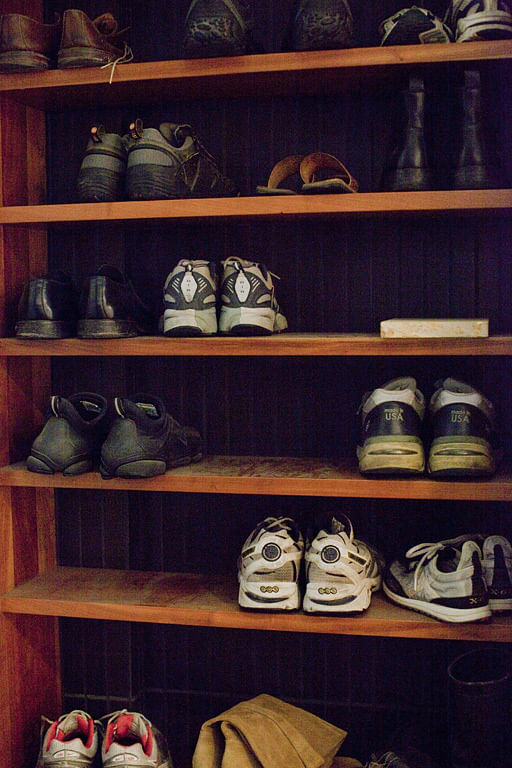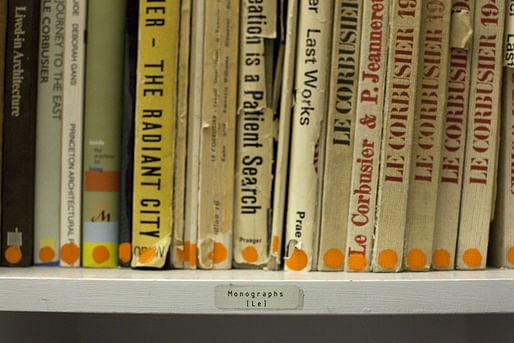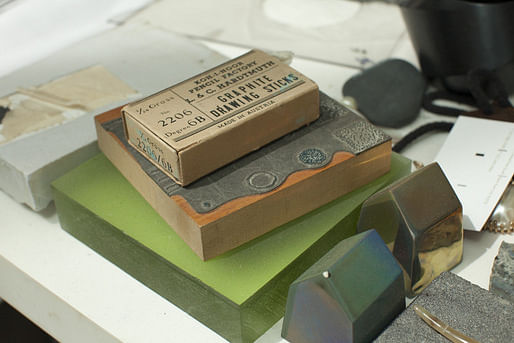
We are delighted to devote the entirety of this episode to an interview with Tod Williams and Billie Tsien. Our discussion spanned their nearly 30 years (and counting) working together, focusing not on individual projects but their architectural philosophy, their material explorations, and their work with landscape. The rising cream throughout was the way Williams and Tsien talk with one another, each pulling on their side of the rowboat to work towards a truly collaborative response.

As always, you can send us your architectural legal issues, comments or questions via twitter #archinectsessions, email or call us at (213) 784-7421. And if you can, we'd love for you to rate us on iTunes or Stitcher!
Listen to episode twenty-two of Archinect Sessions, "Starts with me, ends with us":
Shownotes:
And a few snapshots from inside TWBTA:





25 Comments
One of my favorite firms! nice interview guys!
Thank god for this... answer to everything wrong in the media. Architecture needs more slowness and depth...less branding.
For me, this conversation, felt like a transformative moment in my going forward as an architect. There were so many more questions we had formulated, but as Billie and Tod kept talking, the questions answered themselves.
Oh man. During the entire interview I had a huge smile on my face and after listening to it again just now the smile remains. They are such amazing practitioners of our discipline, and examples for any discipline of being passionate and simultaneously considered and considerate of your work and how it impacts others.
Thanks for this. Faith in architecture is back. It is up to us to bring back the profession. Thanks for posting the Slowness essay too.
I enjoyed this interview. They seem like a very nice couple with good values.
Maybe the questions could have been a little sharper and more skeptical. I was surprised that the Folk Art Museum didn't come up at all, for example.
Thanks for the kind words davvid. When we were putting together our questions, we explicitly decided to not bring up AFAM. Tod and Billie have already fielded countless questions about it, and even published a formal response on their old website. We wanted to highlight the firm's culture and sensibility, not focus on old controversies.
I totally understand not wanting to retread territory that has already been covered so much already.
Its just that I personally wonder about the fragility of such a highly idiosyncratic approach to architecture.And the Folk Museum building's destruction seemed to demonstrate a kind of lack of resilience. Tibetan sand painting comes to mind. Their work seems to require very specific conditions to work well and maybe a degree of protection to last long into future.
And somebody has to do the commercial work and deal with the host of other problems related to cities, capitalism, globalization, speed, media, etc etc.
But don't get me wrong, it was an enjoyable podcast to listen to.
The destruction of the Folk Art building doesn't indicate lack of resilience; it indicates Lowry, MoMA, and DS + R's greed and poor financial planning on the part of the Folk Art Museum as an organization. There's no reason the building couldn't have been used for smaller exhibitions.
Justifying a buildings' demo by calling it idiosyncratic is the definition of shifting blame. It's a classic republican branding tool. Lowry should know since the supposedly progressive MoMA is run by a hard core republican millionaire board.
Whoa? Huh? Lowry and the board had it out for Folk Art Museum, since it's initial planning. We did a podcast about this in February 2014. This was a pissing contest, and when the economy tanked, MoMA, like vultures they are, pounced. Was it idiosyncratic, yes, however, the building could've been saved and made very interesting. I don't think DS+R were given any real chance of making it work, despite my snark at the end. It wasn't about anything, but Lowry's dishonest gesture to "trying" to save the building.
If I thought there was an opening to ask about the Folk Art Museum, I would've taken a shot, but the tone of the discussion was on a level that, in the moment, seemed different than other interviews I've read.
Lightperson, I'm not trying to absolve MoMA of any blame. I'm trying to understand the demolition in the context of TWBTA's work. They're not OMA, for example. They didn't found a firm inspired by the chaotic dynamism of NYC ("fire of manhattanism"). OMA is inspired by the chaos and engages in it through buildings, publications and exhibitions. And OMA has even directly engaged the issue of designing for post-occupancy. TWBTA doesn't seem to have a strong integration of sociological ideas in their work. And they've demonstrated a kind of resistance to the more uncomfortable aspects of culture, capitalism and the profession. As a model for a firm, i think that seems very limited. It relies heavily of very wealthy clients who share their particular values and are prepared to work at a certain pace.
Perhaps a Folk Art Museum building by any other architect would have also been demolished to make way for a MoMA expansion. I don't really know if staggered floor plates were just a scape goat.
What has OMA got to do with TWBTA? Why do you keep trying to force them into a box they don't fit into? There's room for both types of practice. Post-occupancy is less of a concern in their work because for the types of programs they take on that's generally less of an issue; the uses they design for are often viewed as permanent.
Ken,
It was a very nice interview and it did include many details about their history that I wasn't aware of. The "extra-ordinary" explanation was interesting. And Tod Williams' brief explanation of the influence of his father was fascinating. They seem like very good people. They actually remind me a lot of my current bosses, whom I adore.
Davidd, to be honest, I have to listen to the interview. Have a tough time with listening, during the interview all I kept thinking was how great it was to hear both talk about the process, and less about individual works. When they talked about their legacy, I don't know if you could hear it, but I felt my voicing cracking a bit, when I talked about what I perceived their legacy. In that interview, everything they said, it all just clicked for me. I don't know if they're saints, but in my mind, they approach what it means to me to be a good steward of the profession.
jw468, You're getting defensive. I'm just contrasting the two firms to highlight the differences and to make clear, using a specific example, why I see TWBTA's approach to architecture as decidely narrower and more limited. I agree that there is room for both types of practice, as well as many other types of practice. And there are probably flaws in every type of practice that are worth discussing. There are certainly flaws in OMA's model, many of which Koolhaas points out himself.
Ken,
They've made choices about how they are going to practice and which aspects and traditions of architecture they are going to engage with. And they do what they do very well.
So I wonder about the aspects that are not as visible. Like explorations into the city, globalization, sustainability and the public good. They seem politically engaged personally. So I wonder if or how that is expressed through their work. Especially since they seem to be very willing to express other personal values through their work.
I finally finished listening. Great interview! Donna, you mention the lecture in Michigan; was that the 1998 Charles and Ray Eames Lecture? If so, it was published as a book that can be read online.
Williams and Tsien’s books are few and far between. The most recent is WUNDERKAMMER (2013), which was mentioned; then THE ARCHITECTURE OF THE BARNES FOUNDATION (2012, I haven’t read this one); ART AND USE (2007, like the above book, a lecture in written form); WORKLIFE: TOD WILLIAMS BILLIE TSIEN (2000); WILLIAMS TSIEN: OBRAS/WORKS (1999, 2G International Architecture Review 9); and the book for the ’98 Eames Lecture. A+U 1993:08 275 has a lengthy article with an essay that’s similar to “Slowness” entitled “Work Reflects Author’s Life.” Because it’s relatively short and inaccessible, I’ll try to post it below (it's kind of long to post as an image, so it may not post.
Wow, thanks for that link, jw468! There goes all the work I was planning to do this weekend...
No, I saw them earlier than that. I think it was between 1990-93, though my memory of it is fuzzy. I *think* it was at UM, but might have been in Ohio - we sometimes would drive a few hours to see good lectures back then. I recall being so impressed with how they not only finish one another's sentences, but interject a phrase or two that the other then picks up and weaves all back into a single thought - much like their work. They are so attuned to each other, which makes me think they are very present in the moment, effortlessly so.
You're welcome! Here's the A+U essay (A+U 1993:08 275):
jw648 many thanks /\ (again why Archinect is much cooler than the eye candy sites)
Great interview and I agree with just about everything Tod Williams and Billie Tsien do and say about architecture....but the one word that still makes me cringe to this day
Slowness.
If it was any other word, like say Focus, I might complain less, or Concentrate, or Reflect, or Meditate, although that would be less successful as a word...slowness is just somehow offensive to me
(anyway, banned the kids from any technology all weekend even though it's a great baby sitter...smart phone and internet no different than television and tape decks...brain goes to mush with all that incoming data and nothing outgoing...arts and crafts all weekend)
jw, I purchased the Wunderkammer book, just before the interview, and was going to ask Tod and Billie why it was they didn't make a whole lot of books, but then they mentioned not doing a lot of archiving, and I figured that they would probably say that it wasn't something that interested them.
Chris, "slowness" may bother you today, and I remember after the economy hit the shitter I was thinking about "slowspace", however, given that they were thinking about this in 1999, and I hadn't even known they already were working there, and just defining what they were already doing, I have less a of problem with it than I might have, if they were ones prone to cashing in on "coolness".
Ken I don't want to sound negative about it, but I don't like the word personally and I think it opens up a lot of criticism in the sense of being an architect who is detached from society kind of thing....see Davvid's comments above. The actual article itself is excellent and I agree on a lot of stuff....
I mean if they said "focus/reflect" it would probably be demeaning to other architects and the general public probably wouldn't care, but "slowness" opens up the public's perception (commercial clients) as if they weren't interested in the outside world...which isn't to say the outside world is all "commercial", but it's damn close....and I'm sure you have experienced enough fast pace money crunching commercial jobs to understand why not being entertained by commercial clients is a good thing....most the time it's finish half-ass drawings, keep your fingers crossed and hope for the best while everyone is yelling because they don't understand why everything isn't done yet and why everything isn't worked out yet...
There are some good essays on OOO (Object Oriented Ontology) in Log 33, one discussing a Graham Harman text (want to say the Mark Foster Gage essay)...on tools - breaking down Heidegger and tools as an unnoticed background until they don't work...the analogy is made to Architecture as tool I think, but in the context above we are discussing the tools of being an architect and our methods of production.
...oh man lost my train of thought, not sure I'll get it back, kids running around, wife having issue with the camera.....
either way, I prefer "slowness" over "coolness" by a mile...
and yes I had heard the Sherman-Williams rumor once too, thanks to your podcast that has been cleared-up.
I thought it was a good interview also, even if not a fan. I especially like slowness in the sense of quality and the slow food movement that's more about presence than flash. The only quibble I had with their answers was the refusal to engage commercial work. It's certainly their prerogative, but I question that the requirements of commerce preclude good architecture. There's no one ideal scenario required to produce good architecture if you believe the solution will be born addressing the problem at hand straight forwardly.
best podcast yet guys.
I was interested to hear that concept design is not a team sport and I totally support that idea, coming from a collaborative office. It was great to hear how they include everyone in all aspects of work in the office. That's how it should be in my opinion, and software is not a prerequisite nor an obstacle to them, it seems.
I liked hearing how they find opportunities for design in all project phases. We do that and it can be a challenge to manage construction documents. It definitely keeps the work fun, especially on the longer projects. You're never babysitting a project if you saved something for later.
I loved the slowness idea. i am THE revit guy, but I have to say WHITEOUT ROCKS!
Block this user
Are you sure you want to block this user and hide all related comments throughout the site?
Archinect
This is your first comment on Archinect. Your comment will be visible once approved.